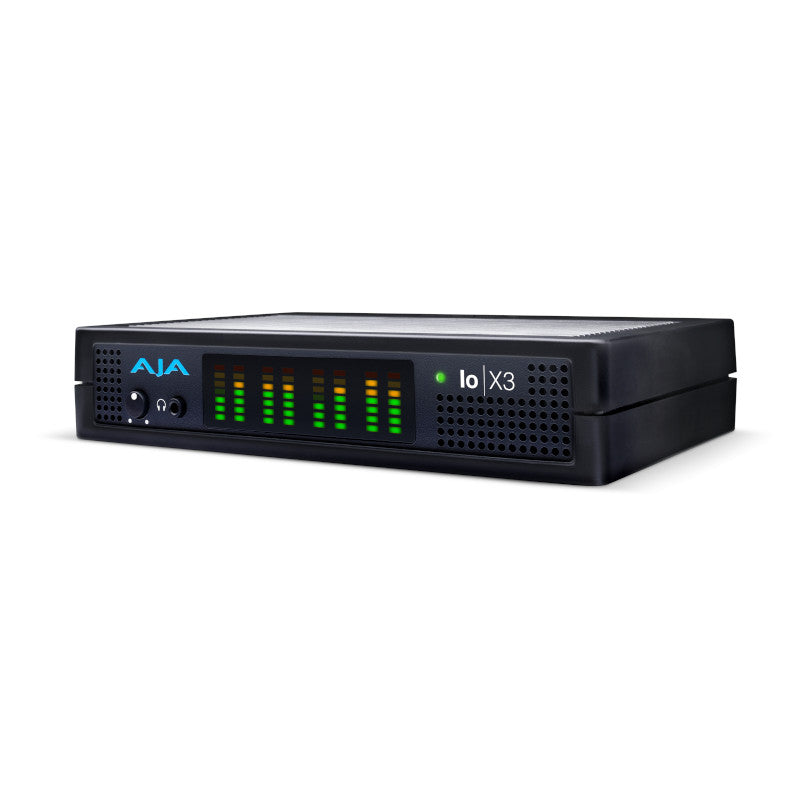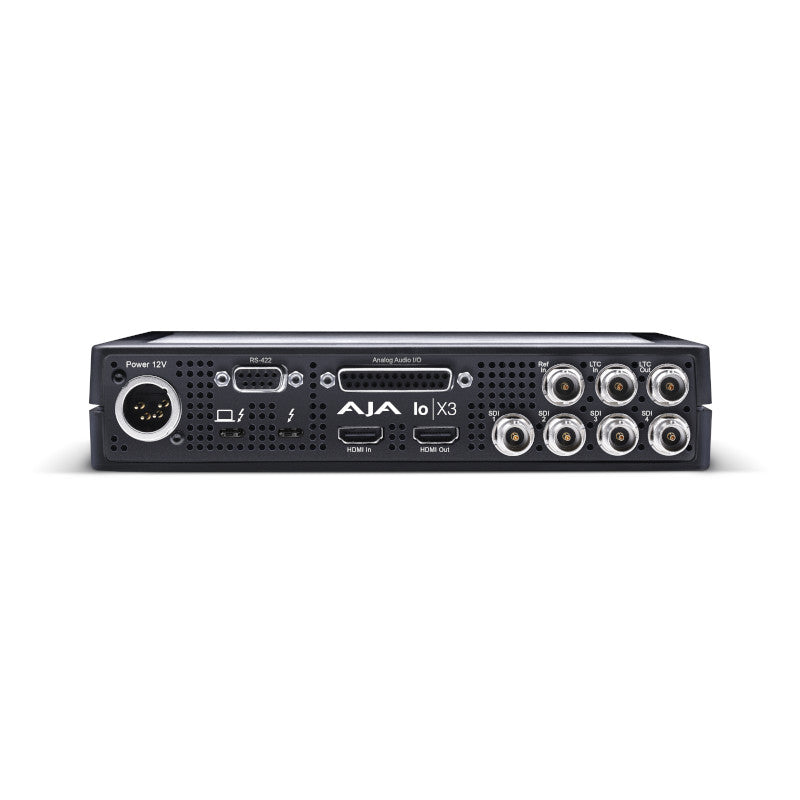AJA Io X3 IO Card
Couldn't load pickup availability
Description
Overview
AJA Io X3 is perfect for high quality HDR or SDR video work with up to 60p HD/2K signals or files with support for all major NLE applications as well as other video applications such as OBS Studio, vMix and Telestream Wirecast. Connecting with a single Thunderbolt 3 cable and providing a second Thunderbolt connector for flexibility, Io X3's compact and quiet form factor is ideal for on set, in the studio, at an event or in the edit suite.
Features
- 2K/HD/SD I/O up to 50/60p
- 4x bidirectional 3G-SDI BNC with 16-channel embedded audio
- HDMI I/O with 8-channel embedded audio
- Two Thunderbolt 3 ports with loop through
- Multi-channel workflow support for OBS/Wirecast/vMix and other applications
- YCbCr 4:2:2 10-bit up to 60p
- RGB 4:4:4 12-bit up to 30p
- VPID signaling for SDR/HDR Transfer Characteristics, Colorimetry and Luminance via SDI
- PQ, HLG, HDR10, HDR10+ and Dolby Vision Support
- HDR Metadata Capture and Auto Playback Detection
- Multiview output over HDMI, to view up to 4-channels on one screen
- Analog audio flexibility with a choice of 8-channel In or 8-channel Out or 4-channel In and 4-channel out via a standard Tascam connection
- Front panel audio display
- Includes support for the Apple M1 chip and the latest OS versions
- XLR 12V power for battery or AC use (AC adapter included)
- Headphone jack and level control for mobile and live environments
- RS-422 VTR control, Reference, LTC Input and LTC Output
Versatile and Practical Connectivity
The Io X3 rear panel offers a wealth of easy to access connectivity for almost any need in SD/HD/2K video pipelines. Power is supplied via industry standard 4-pin XLR with either the included AC adapter or battery power. Dual Thunderbolt 3 ports provide host connectivity to a laptop or desktop PC or Mac, with the second port for loop through to other Thunderbolt devices. RS-422 is included for machine control of external devices so they can be synchronized for editing. Analog audio is offered via a DB-25 port, with all 8-channels configurable to be in or out. HDMI in and out ports allow for easy monitoring or video input sources to be accessed, including HDR and SDR video. Reference input connects the Io X3 to any master clock source alongside LTC input and output for timecode. Finally, 4 bidirectional 3G-SDI ports can be configured as multi-channel inputs or outputs to suit the video application of choice, offering immense flexibility in the field, editing suite or on-set.
Universal Compatibility:
Thunderbolt™ 3 via USB-C
Io X3 Plus provides two Thunderbolt 3 ports for true Thunderbolt flexibility.
Thunderbolt 3 doubles the speed of the previous Thunderbolt 2 standard with up to 40 Gps of throughput and utilizes the universal USB-C connection standard for true simplicity over a single cable for today's leading Mac and PC workstations and laptops.
Thunderbolt™ 3 features:
- Thunderbolt™ and power on one cable
- USB-C connector and cables (small, reversible)
- 40 Gb/s: Thunderbolt™ 3 – double the speed of Thunderbolt™ 2
HDR
HDR or High Dynamic Range, provides the ability to display a wider and richer range of colors, much brighter whites, and much deeper, darker blacks than standard signals allow. This gives your imagery a more ‘dynamic’ look and allows for natural true to life colors to be communicated to your audience.
Io X3 provides this support for your 2K and HD HDR pipelines to HDMI and SDI compatible displays in software v16.2 with HLG and HDR10 support with HDR Infoframe metadata, in accordance with HDMI 2.0a/CTA-861.3 and HD.
AJA Control Room software and Io X3 adds support for HDR metadata capture from an incoming SDI or HDMI signal. The captured .mov video file will have embedded HDR metadata, allowing the file to be played back at its intended dynamic range.
AJA Control Room software and Io X3 Plus also provides HDR Auto Playback Detection. Embedded HDR metadata in a recorded .mov file is read and used to automatically set the HDR format on the monitor(s) connected to the HDMI and/or SDI outputs.
Support for file-based .mov HDR outputs with metadata from Adobe Premiere Pro / Adobe Media Encoder HDR files is also available. Screening those rendered outputs is a simple and high-quality experience with AJA Control Room. Every frame is presented in its full-quality, at the timing intended, and with the proper HDR format set correctly and automatically.
v16.2 Desktop Software also offers HDR input from HDMI for capturing HDR gaming content and more.
Use Case: NLE Workflow for Io X3
Io X3 offers broad support for all major NLE applications, including Apple Final Cut Pro, Avid Media Composer and Adobe Premiere Pro with a host of practical and easy to use features, shown in this NLE workflow diagram. The Io X3 sits at the center of the NLE workflow, connected directly to the host laptop via super fast Thunderbolt 3. The NLE software is running on the host laptop, with the output of the time line being shown via both the HDMI port and the 3G-SDI port simultaneously, with support for HDR and SDR monitoring. The analog audio jack on the front of the unit provides easy headphone monitoring, whilst at the same time a standard Tascam DB-25 loom connects an analog mixer and microphone to the workflow, with the front panel VU meters responding to the independent channel levels. An AJA Ki Pro Ultra 12G is connected for real time recording of the NLE output to Apple ProRes or Avid DNxHD codecs for archive or hand-off. Whether editing promos, news footage, sports, long form content or any other demanding video environment content, Io X3 is your perfect partner.
Use Case: OBS Workflow for
Io X3
Io X3 is directly compatible with OBS Studio, offering a comprehensive toolkit for mixing live video and taking the program content out to streaming destinations. Io X3 again sits at the center of the workflow pictured opposite, providing the necessary video I/O for a 4 camera source program. Via Io X3's multi-channel support, the 4 HD cameras are connected directly to the 3G-SDI ports of the Io X3 which is connected via Thunderbolt 3 to the host PC or laptop. The host computer runs the OBS Studio software and allows you to view all incoming HD sources in a single multiview via the HDMI port to any display. Audio can be monitored via the built-in analog headphone port. The final PGM stream is output from our switched sources via the host computer.





